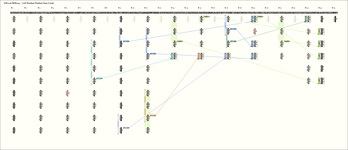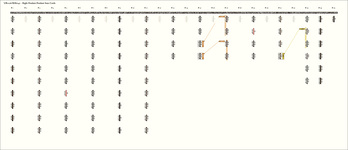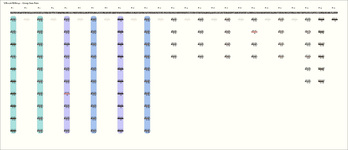| Notes: |
Ascher Databook Notes:
- This is one of several khipus acquired by the Museum in 1907 with provance Ica. For a list of them, see UR1100.
- By spacing, the khipu is separated into 3 parts. By spaces smaller than that between the parts and by markers, part 1 is separated into 6 groups of 10 pendants each, and part 2 is 6 groups of 4 pendants each (with 2 additional pendants in the last group). Part 3 is 1 group of 6 pendants.
- Each group is unified by color. In part 1: group 1 is CB-W or CB-B; groups 2 and 6 are DB-W; groups 3 and 4 are CB-W; and group 5 is CB. The markers between them are short B cords. In part 2: groups 1, 2, and 4 are CB-W; group 3 is DB-W; and group 5 is B-W. In group 6, 4 of the pendants are GG-W and 2 additional pendants (1 between positions 1 and 2, and the other between positions 2 and 3) are DB:W. In part 3, with the exception of the first pendant, the group is DB-GG.
- In part 1 (assuming that the missing P27 had value 20):
- The only pendant values are 11, 12, 20, and 21 and the subsidiary values are 0 or 1.
- The 60 pendant values sum to 1000.
- All the values in corresponding positions are the same for groups 1, 2, 3, and 4. With the exception of the interchange of values in positions 2 and 3, the values in group 6 are also the same.
- In part 2 (assuming that the missing P74 had value 40):
- The only pendant values in positions 1-3 of all groups are 20, 30, 40, 50, 60.
- The sum of the values in each of the first 3 positions in the 6 groups is 250.
That is:
\[ \sum\limits_{i=1}^6 P_{i1}=\sum\limits_{i=1}^6 P_{i2}=\sum\limits_{i=1}^6 P_{i3}= 250 \]
|











